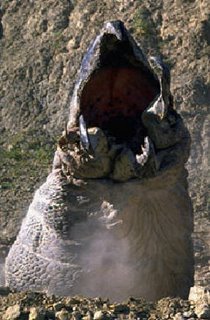
Giant earthworm resurfaces after nearly two decades
PALOUSE, Wash. -- Pity the poor robin that latches onto one of these worms.
A yard long and as big around as a man's pinkie finger, the giant Palouse earthworm is albino-pale, can burrow 15 feet deep and smells like a lily.
The recent discovery of one of the scarce giants has energized entomologists and soil scientists, who fear it may be near extinction.
"It was very exciting. Just to find something we thought, perhaps, was gone is a great thing," University of Idaho soils scientist Jodi Johnson-Maynard said.
The native giant earthworms have been found by scientists only four times since the 1970s. None had been seen since the 1980s until Idaho graduate student Yaniria Sanchez-de Leon dug one up while studying other earthworm species in May 2005.
It wasn't until last January that worm experts confirmed she had found Driloleirus americanus, the giant Palouse earthworm. "I wasn't looking specifically for it. I was hoping it was around," Sanchez de-Leon said.
Little is known about the giant worms: how many there are, where they live, how they behave, or why they are so scarce.
Scientists aren't even sure how big they get. Reports of 3-foot-long earthworms come from before the Palouse region of Eastern Washington was carpeted by wheat and other crops more than a century ago, Johnson-Maynard said.
Specimens found in modern times have been 18 inches or less. A giant worm in Australia, by comparison, can reach 10 feet.
Sanchez-de Leon thinks the 6-inch-long version she found - a little longer and fatter than a common nightcrawler earthworm - might be a young adult.
One reason so little is known about the giant earthworms is, well, they're worms.
Unlike the celebration touched off by last year's sighting in Arkansas of the ivory-billed woodpecker - a bird not seen in 60 years and thought to be extinct - the giant earthworm Sanchez-de Leon found last year already has been consigned to a jar of formaldehyde.
"Realistically, the giant Palouse earthworm is a lot less charismatic than a giant woodpecker," said James "Ding" Johnson, head of the University of Idaho's Department of Plant, Soil and Entomology Sciences. Johnson, himself, found several of the giant earthworms during graduate studies in the late 1980s.
There is urgency to find more Palouse giants because earthworms play an important part in the health of soil and plants, the scientists said.
"Earthworms are considered nature's tillers. They're extremely important for soil quality and from the standpoint of managing to grow plants better," said Ann Kennedy, a Washington State University soil scientist and veteran of several unsuccessful giant Palouse earthworm expeditions.
"It's one of a whole group of macrofauna that burrow and move organic matter from the surface down to deeper depths," Kennedy said. "It's amazing how far down you can find matter."
Sanchez-de Leon spent two years digging in WSU's Smoot Hill Ecological Reserve north of Pullman, about 65 miles south of Spokane - where the giant earthworm had been found previously.
The 800-acre reserve is thought to be one of the last remaining segments of the 2 million-square-acre Palouse shrub-steppe prairie of north-central Idaho and southeastern Washington.
The Palouse region was formed from ashfalls from Cascade Mountain volcanic eruptions. The wind-blown loess is hundreds of feet deep in places and supports a carpet of wheat on rolling hillsides.
The Palouse-area scientists think the earthworm's length and feeding habits might contribute to its scarcity.
These earthworms don't regenerate when cut by plows and tillage disturbs the layer of surface vegetation where they eat, the scientists think.
Other factors could be changes to their native habitat, or competition from other species of earthworms brought West by settlers, the Idaho and WSU scientists said.
Because the giant worms may "hibernate" deep underground until surface conditions are just right, it is not known how many there are, Kennedy said.
"The historic records lack enough precision for us to know how common they were before the Palouse was tilled. There are early oral reports of seeing these giant worms," Johnson said.
Unlike the giant sand worms of "Dune," the science-fiction work made into a movie in 1984, or the man-eating underground dwellers of 1990s movie "Tremors," the giant Palouse worms appear to eat only vegetation and an occasional insect.
That lily scent the worms are reported to give off is thought to be a defense mechanism, Johnson and others said.
European worms, which were brought West by settlers, may have crowded out the native worms, Johnson said.
"We're not exactly sure why they're going extinct," Johnson said. "Apparently, the natives did not evolve with tillage, with the plants we've introduced. We've changed their ecosystem and introduced a competitor."
Kennedy said scientists from Idaho and Washington State - land grant universities eight miles apart in the heart of the Palouse - will continue to look for the giant worm that has proved to be as elusive as another Northwest legend.
"It is kind of like a Bigfoot thing, but that's OK," Kennedy said. "Lately, worms are the big thing. People used to think they were kind of icky and now there kind of neat to talk about."




5 Thoughts:
Wow, now I feel so guilty for clubbing the hell out of that earthworm when I was gardening last week but he freaked me out!!!
I don't like anything that wiggles like that.
But hey, thanks for the education over my morning cup of tea!
the whole "smells like lilies" part is what got to me. say WHA...??
Rock Bitch: You don't like anything that wiggles like that? Anything?
Dorrrn: I know - it's better than smelling like shit, though.
oh God did you know that there are like 5 sequences to that stupid, gay, retard movie 'Tremors'?
I've seen Tremors 1-3.
1 and 2 are good. The first one kicks ass, actually.
|
<< Home